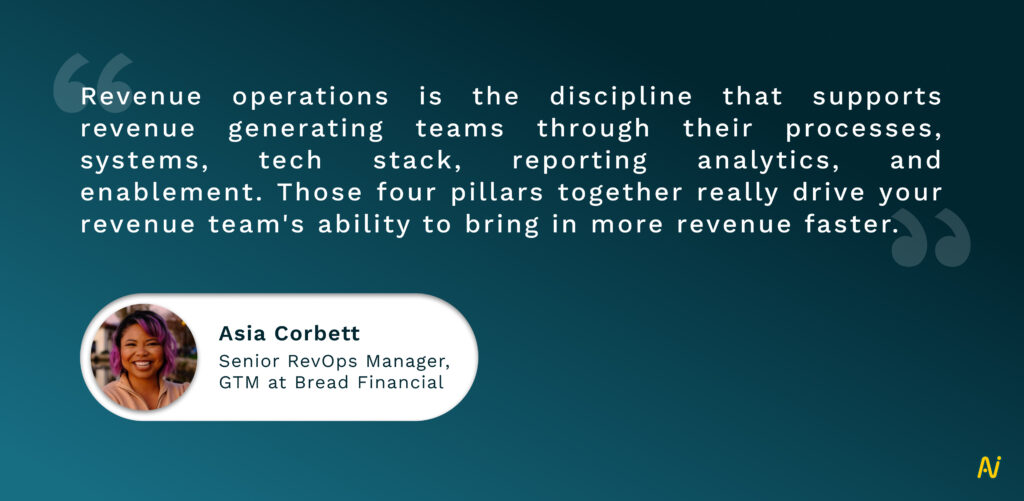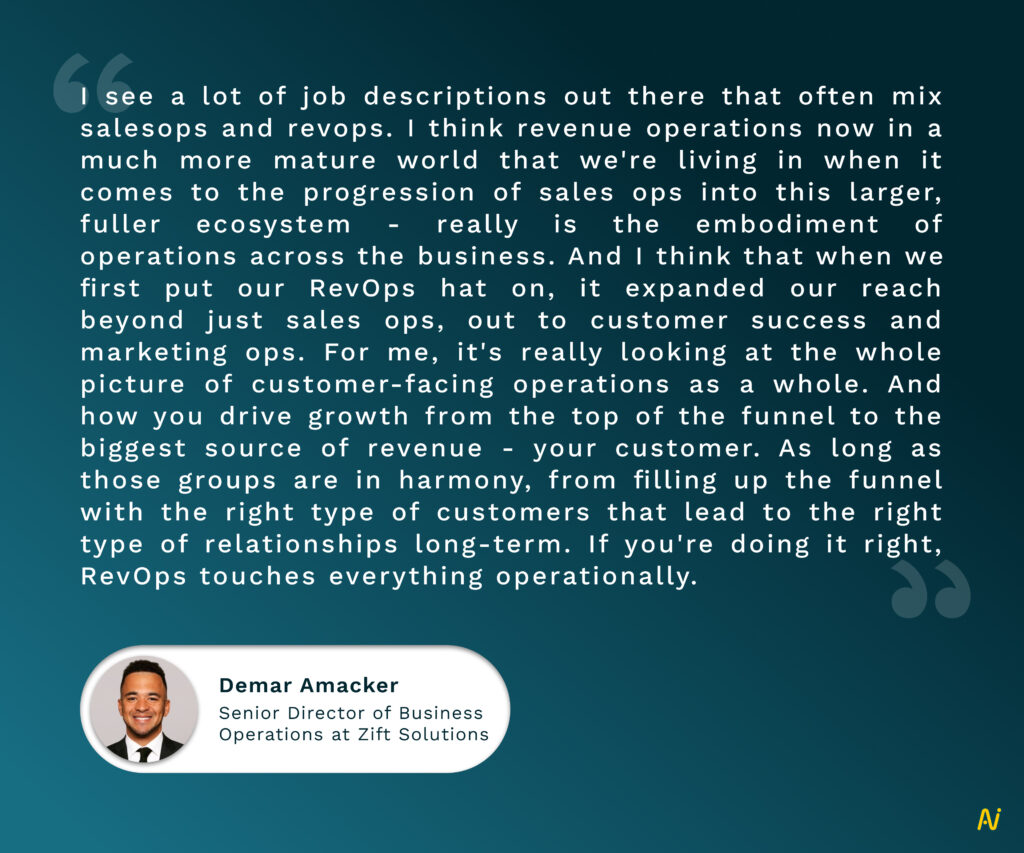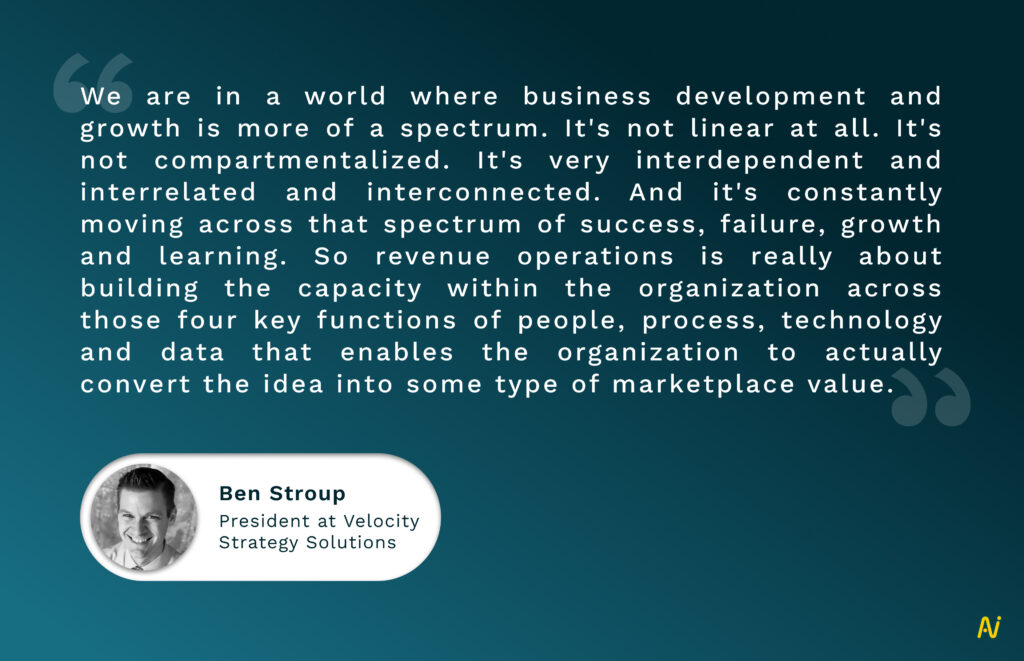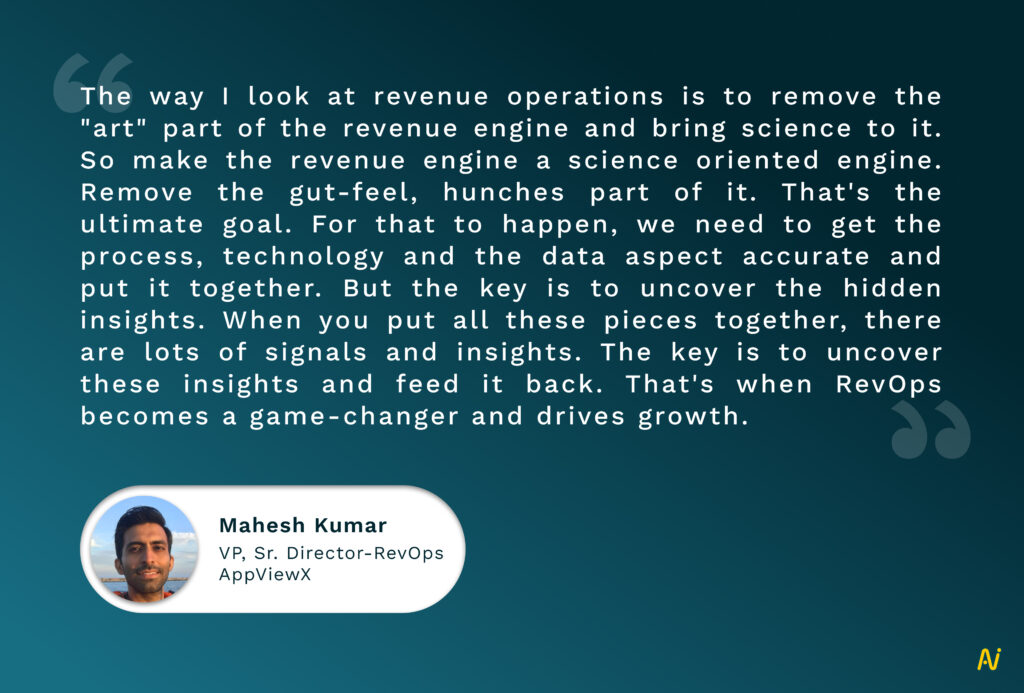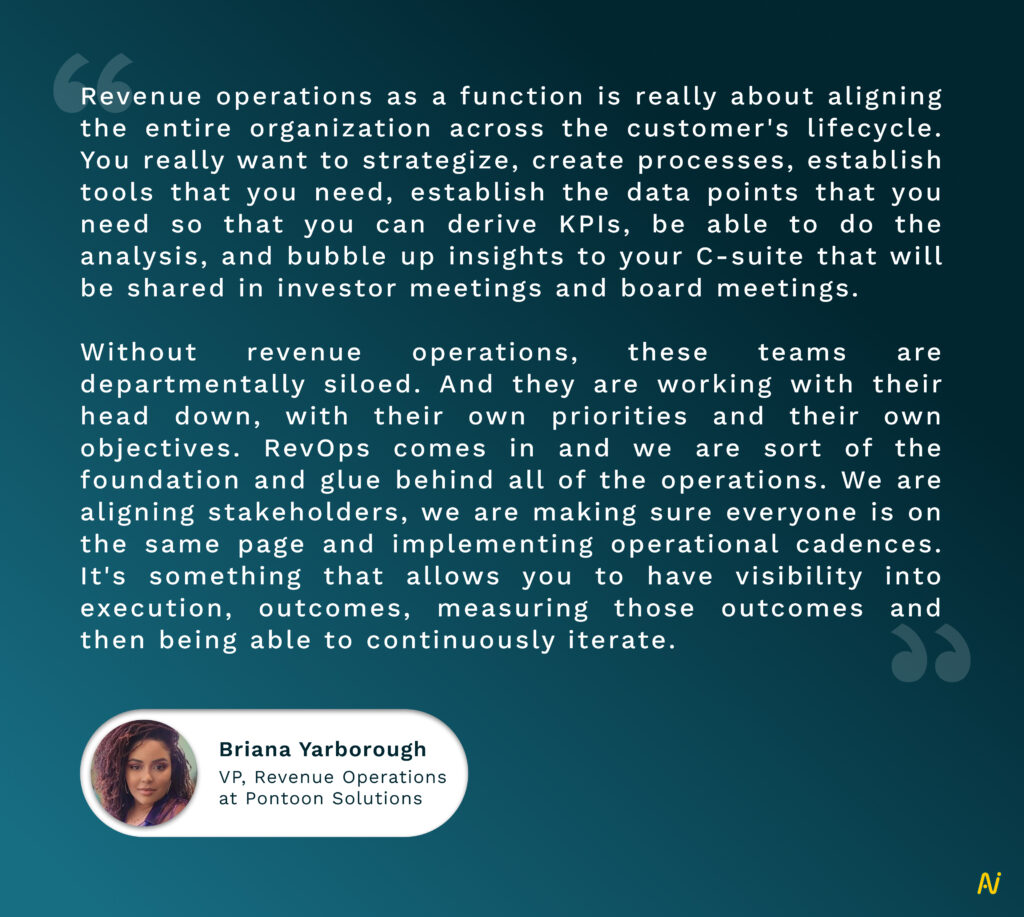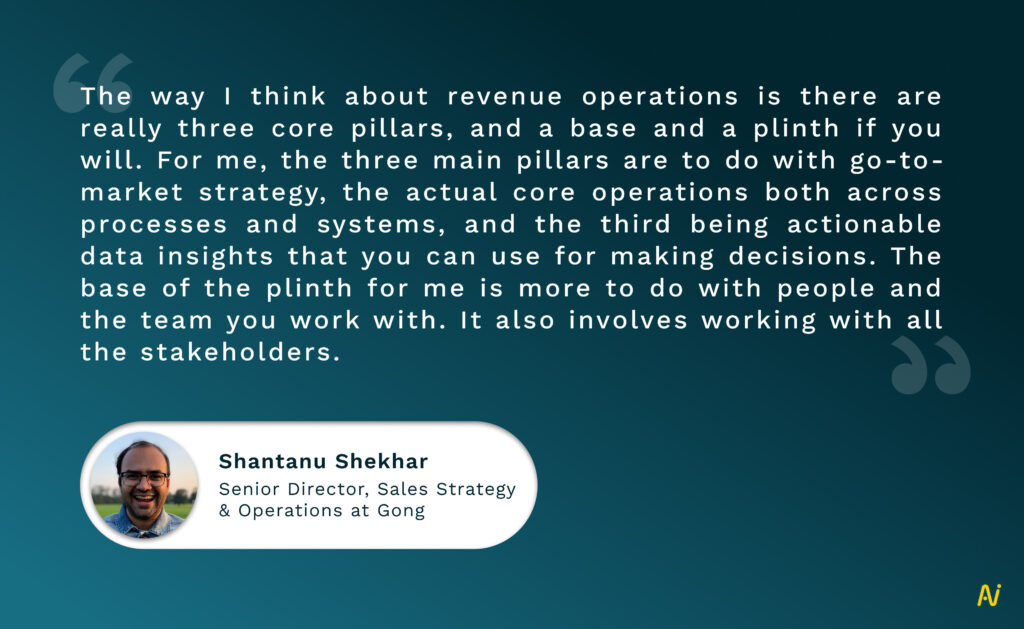The transformation to Revenue Operations (RevOps) as an operating model has been gaining momentum over the last few years.
According to Gartner, 75% of the highest-growth companies in the world will deploy a RevOps model by 2025.
This explains “Head of Revenue Operations” making it to the top list of the fastest growing job titles in the U.S. for 2023.
What is the reason behind these trends?
And what does Revenue Operations even mean?
In this article, we will help you answer these questions.
We will cover:
- What is RevOps?
- SalesOps vs RevOps: What’s the Difference?
- Core pillars of RevOps
- Why is RevOps on the Rise?
- Which are the Key Players of a RevOps Function?
- What are the Benefits of a RevOps Function?
- What Metrics Are Used to Measure RevOps?
What is Revenue Operations?
Revenue operations or RevOps is an end-to-end operating model that helps organizations run their business in an interconnected way across GTM functions like sales, marketing and customer success.
A tight alignment of the GTM model enables organizations to drive predictable revenue.
The role of RevOps is to drive visibility, accountability and transparency across the entire revenue funnel, improve efficiency across a unified revenue process, and unlock potential for revenue growth.
RevOps connects teams, processes and people that have been otherwise functioning in silos.
It also aligns them to work towards common revenue goals.
RevOps vs SalesOps: What’s the Difference?
Sales operations (SalesOps) is a function that supports the B2B sales process.
Related Resource: RevOps vs SalesOps - 6 Key Differences
Revenue operations (RevOps) on the other hand is a function that is responsible for operations across all revenue-generating teams like sales, marketing and customer success.
In that sense, SalesOps is a subset of RevOps. RevOps will do all that SalesOps does. Along with sales, it also looks over other revenue generating functions like marketing and customer success and keeps the entire GTM function aligned.
Core Pillars of a RevOps Function
Revenue operations or RevOps has four key pillars. Each pillar acts as a critical component to drive alignment, collaboration and efficiency across the customer journey. It’s absolutely essential to clearly define all these core pillars to run a predictable and repeatable revenue engine.
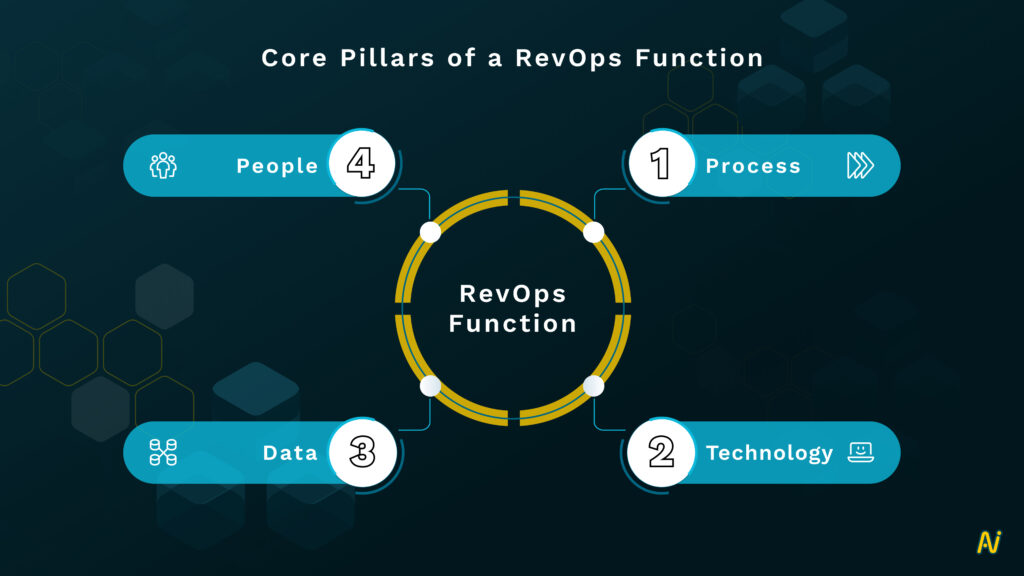
Process
RevOps enables a seamless customer experience from lead to cash. To do this, multiple processes are set up at various stages of the customer journey to operationalise the entire process towards revenue generation. These processes have to be iron clad and consistent.
Technology
RevOps function relies on several tools in the technology stack to ensure processes run smoothly. RevOps teams are responsible for choosing these tools carefully. And making sure they help revenue teams stay productive and efficient.
Related Resource: What an Ideal RevOps Team Structure Looks Like
Data
Data is the heartbeat of any successful business. Clean and complete data in systems like CRM is the foundation of a successful RevOps function. And the insights from this data is critical to drive strategic decisions to help move the business forward.
People
The final pillar is the team of people in charge of managing the operations behind these systems, processes and data. Depending on the size of your organization, the size of this team will vary.
Reasons for Increase in RevOps Teams
There have been several developments that have aided the increase that we see in RevOps roles.
Let’s explore these reasons:
1. A need for achieving better GTM alignment
Sales, marketing and customer success teams have traditionally been operating as separate functions with their own tech stacks, plans and resources.
These teams derive insights from their own data sets, and use them to follow separate department-led growth strategies.
Such a disconnect in goals, data and strategies leads to uninformed and inaccurate decisions that ultimately hurt revenues.
Let’s assume marketing meets one of its goals, like an ebook download. Now, if those leads are not getting passed down to sales, the entire revenue organization falls under risk.
Functioning in such silos is no longer acceptable, which calls for a function that brings all siloed functions under one roof.
2. An increased access to rich data-driven insights
There has been tremendous development in the field of automation and artificial intelligence (AI) that has enabled companies to have access to real-time, accurate and meaningful insights to make their processes more efficient.
With the right tech stack, companies are able to make data-driven decisions, and pivot wherever necessary to continually improve their internal revenue-generating processes.
Technology has made it possible for companies to have visibility into their data, and use it to continuously improve, adapt and drive revenue growth across the GTM model.
Today, a RevOps function can utilize the capabilities of a modern tech stack and use it to drive predictable growth.
3. A transition from a top-down funnel to a revenue flywheel
Businesses today are no longer just about acquiring new customers. They have to continuously engage, upsell and offer value to existing customers.
The increase in subscription-based business models has made the role of marketing, sales and customer success continue even after a sale is made.
Keeping this recurring revenue model running requires an end-to-end alignment of the revenue process along the buyer journey.
This is possible when there is alignment up and down the entire GTM model. This sync ensures a seamless flow across data, systems, processes and teams, from the moment a customer shows interest in a product to the transition to customer renewal.
4. Drastic changes in buyer expectations
The rise of tech and real-time access to information has made today’s buyer more empowered than ever before.
They do their own research even before the sales rep can reach out to them for the first time.
They are armed with knowledge and expect no hurdles when they move from one stage of the purchase journey to another.
Understanding this buyer’s expectations, offering value in exchange and making the entire purchasing experience seamless is what can make companies differentiate themselves in the market.
5. A surging need for consistent tech stacks across GTM
There has been a rising concern about the increasing number of tools that sales and marketing teams use on a daily basis.
For instance, an average sales organization today uses over a dozen sales tools. This is 4 times more than what they were using just a decade ago.
Despite investment in these tools that promise improving rep productivity, the results have been quite opposite. For sales teams, for instance, the average quota attainment globally has fallen by more than 50% in the last decade.
This issue is further compounded by the abysmal rate of rep adoption to new tools. With low rep adoption and too much change management that comes along with new tools and processes, it gets even harder to implement changes that will accelerate revenue attainment.

Key Players of RevOps
A revenue operations function primarily supports and aligns three customer-facing functions in an organization – sales, marketing and customer success.
Sales
A RevOps team is always on top of the sales function. They have clear visibility into what is going on in every stage of the sales process, where the bottlenecks exist, and what can be done to prevent revenue from leaking through the cracks.
RevOps clears the blockages that might be preventing sales teams from doing their jobs effectively. By automating and defining a clear roadmap for sales, RevOps makes sales teams more productive and helps them win more deals.
Marketing
RevOps helps streamline marketing tech and helps marketing teams access data from other revenue-generating functions.
This helps marketing create more customer-centric campaigns that align with sales and customer success goals, creates better collaboration among GTM teams and elevates marketing strategies such as lead generation and customer engagement.
Customer Success
Better alignment with all customer-facing teams helps previously siloed functions work together and create more focused strategies around customer needs.
With a single view of gaps across the GTM funnel, RevOps helps with better customer communication and service, and enhances the entire customer experience across all stages of the buyer journey.
By putting the customer at the center, companies can focus on building long-lasting and trustworthy relationships with their clients.
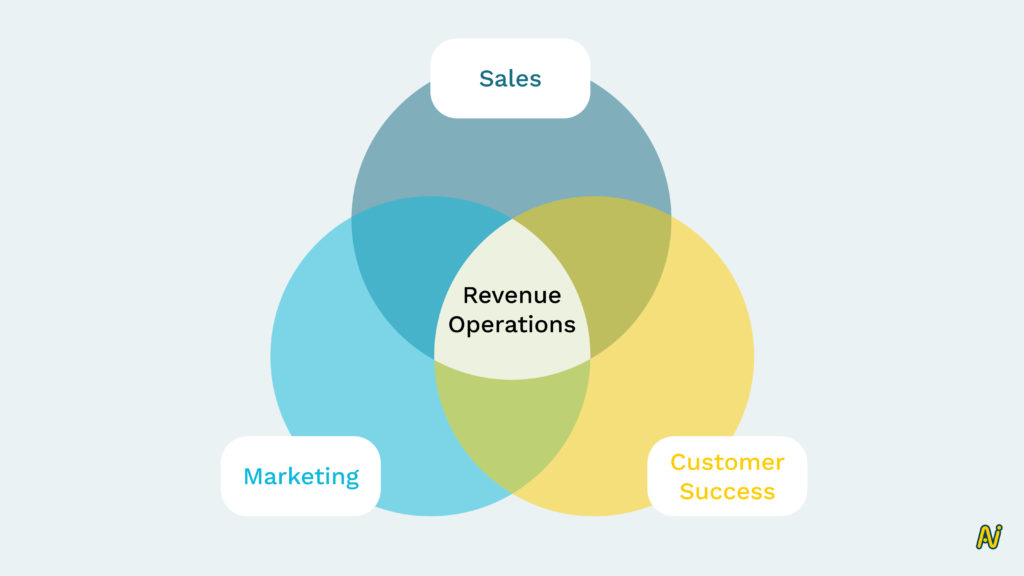
What Kind of Value Does a RevOps Function Add?
Companies that align their GTM functions through a RevOps strategy have outperformed those who don’t.
According to a study by BCG, top B2B companies in the SaaS space have witnessed the following benefits after introducing a revenue operations strategy:
- 100% to 200% increases in digital marketing ROI
- 10% to 20% increases in sales productivity
- 10% increases in lead acceptance
- 15% to 20% increases in internal customer satisfaction
- 30% reduction in GTM expenses
Here are some of the benefits that you can witness with a thoughtfully planned and implemented RevOps function:
1. Tighter GTM Alignment
RevOps helps in achieving better GTM alignment by centralizing all GTM operations into a single RevOps function. This approach breaks the silos of traditional teams and transforms them into a single revenue team.
RevOps function aligns every team’s goals and OKRs around common organizational objectives.
For example, if the overarching revenue goal is to increase bookings for sales, marketing and customer success teams have to support this and work together with sales to reach those numbers.
Because all teams have a single source of data and reports, this data-driven collaboration can be used to achieve shared revenue targets.
This helps drive transparency and accountability across the entire revenue function, right from the C-suite to the frontline.
2. Predictable growth
Centralizing all the customer-facing functions allows revenue leaders access to a single window of data insights.
This view enables them to create, view and assign tasks to cross-functional teams and collaborate on successful playbooks to close more deals.
With this single view, RevOps teams can scale across sales, marketing and customer success functions with clear visibility into all the stages of the GTM function.
Related Resource: How to Build a Successful RevOps Roadmap
With a data-driven machine, RevOps teams can predict growth and revenue through consistent measurement of key metrics.
They can identify lags in real-time and course correct today to achieve better results in the future.
3. Consistent tech stacks
A RevOps function can help commercial leaders take control of and derive maximum value out of their tech stacks.
Since RevOps unites different teams, they allow for the use of a centralized tech stack.
With such tech stack fluidity throughout the teams, everyone is on the same page as they can refer to similar insights within their synchronous set of software tools.
4. Higher customer satisfaction & retention
The modern customer’s expectations are at an all-time high. Knowing exactly what to communicate with customers requires the entire revenue team, right from the executives to the sales rep in the field, to be aligned.
When different departments work harmoniously with one another, they are more attuned to the buyer’s needs. They can work together to offer a seamless customer experience throughout the different stages of the buyer journey.
This will help craft more personalized communication and offerings to the buyer, making them feel heard, and converting them into paying customers.
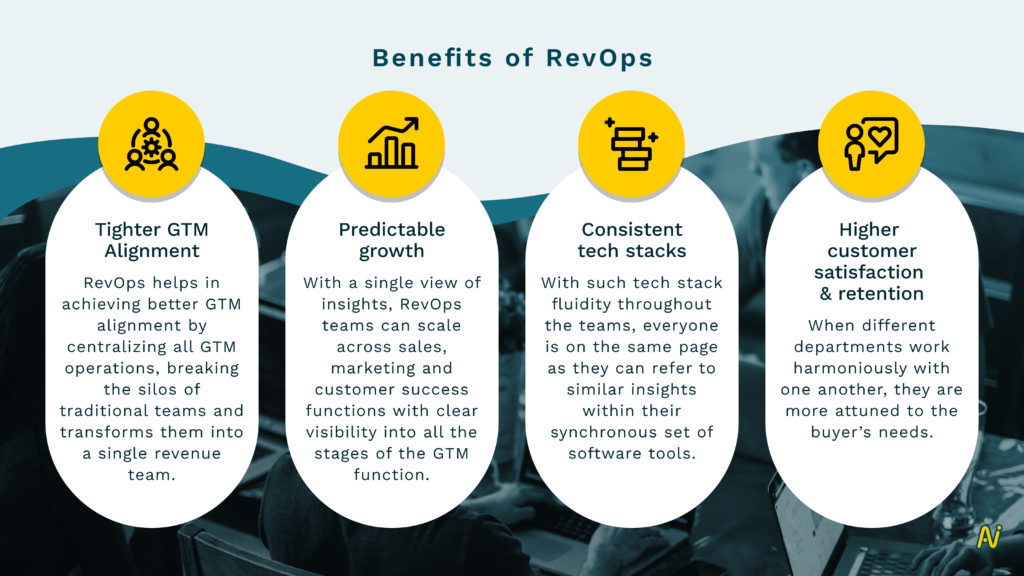
Key Metrics for Revenue Operations
As the name suggests, the foremost goal of Revenue Operations is to drive predictable revenue.
To drive revenue effectively, RevOps teams need to track a few key metrics to get a clear understanding on what is working in their current processes and what’s not.
The gaps in these metrics can help RevOps teams develop strategies to optimize the performance of their revenue teams.
For example, if a metric highlights that sales reps quota attainment has been decreasing, revenue leaders can investigate the reasons for the same, and pivot the sales strategy in a way that helps reps close more deals.
Related Resource: 15 Key Metrics Every RevOps Leader Must Track
Alternatively, if your revenue shows a decline month after month, you can analyze certain sales metrics to figure out why that is so.
Thus, tracking sales metrics help you to:
- Improve your sales team’s overall performance by addressing the bottlenecks in your business.
- Optimize various sales processes by indicating which strategies work best.
- Explore new opportunities by highlighting under-served areas.
- Improve accountability across sales reps and sales managers.
- Help deploy sales coaching in areas that require the most attention.
- Help your buyers and sellers be on the same page.
Here are some of those key metrics RevOps is accountable for:
- Annual Recurring Revenue (ARR)
ARR calculates the value of revenue that a company expects to generate from its customers on an annual basis.
- Average Deal Size
Average Deal Size is the total revenue generated in a chosen period of time, divided by the number of closed won opportunities for that segment.
- Average Revenue Per User (ARPU)
ARPU is the amount of revenue a company generates per user or per account in a given period.
- Average Profit Margin
Average Profit Margin measures how much of overall sales revenue converts into profit.
- Win Rate
Win Rate refers to the percentage of the total number of proposals made that convert into actual sales.
- Conversion Rate
Conversion Rate in sales is the percentage of qualified leads that convert into paying customers.
- Churn Rate
Churn rate is the percentage of customers who either cancel their subscription or do not renew it for the next period.
- Net Revenue Retention Percentage
Net revenue retention is the percentage of a company’s recurring revenue over a given period of time from its existing customers.
- Quota Attainment
Quota attainment is the percentage of deals that reps close in accordance with their goals for that period of time.
- Sales Cycle Length
Sales cycle length is the average amount of time that it takes to complete a sale. This period starts from the first interaction with a potential customer to the time when a sale is made.
- Pipeline Coverage
Pipeline coverage is the ratio of the number of opportunities that exist in the pipeline to sales quota.
- Sales Activity Metrics
Sales activity metrics are the data points that depict the performance and behaviour of your sales team. It captures every action that your sales team is undertaking to close a deal.
- Lead Scoring
Lead scoring is a way to rank prospects or leads on the basis of their engagement with your sales team. This score is assigned to leads on a variety of factors such as buyer behaviour, frequency of interactions etc.
- Customer Acquisition Cost (CAC)
CAC measures the amount of money needed to acquire a new customer.
- Customer Lifetime Value (CLV)
CLV is the total amount of money that a customer will spend during their lifetime on a product/service.
You can dive deep into each of the above metrics, its impact and calculation here
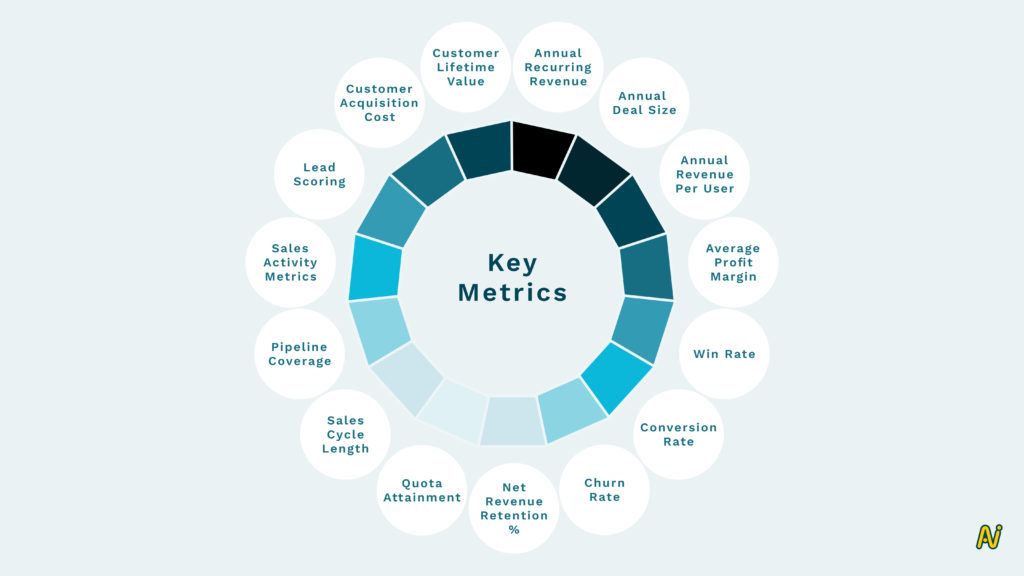
Getting Started With RevOps
A RevOps structure breaks down the barriers between sales, marketing and customer success functions and brings them under one department.
A central RevOps function helps create a comprehensive and well-defined alignment in the GTM model.
RevOps enables data to flow up and down the organization, and across the entire customer journey (from top of the funnel to customer renewal and expansion).
If you face any of the above challenges, be it achieving alignment in your GTM model or driving transparency and accountability throughout your revenue generating activities, you must start thinking about adopting RevOps as a strategy.
RevOps will give your organization a common view of your business performance, allow you to unify and optimize the processes that power your revenue engine and help your customers transition seamlessly from one stage to the next in the buyer journey.
Nektar’s revenue efficiency platform acts as a connective tissue across GTM teams for maximizing revenue efficiency and sales velocity. It offers revenue teams superior CRM data integrity with clean and complete first-party contacts and buyer-seller activities, which it then leverages to push timely revenue insights into Slack and MS Teams for proactive deal execution and collaboration.
Learn more about Nektar’s solution here.
If you’re interested in knowing more about what’s happening in the revenue operations space, subscribe to our podcast – The Revenue Lounge where we interview some phenomenal RevOps leaders and ask them their secrets to running a powerful revenue engine.

Here’s a recent episode:

